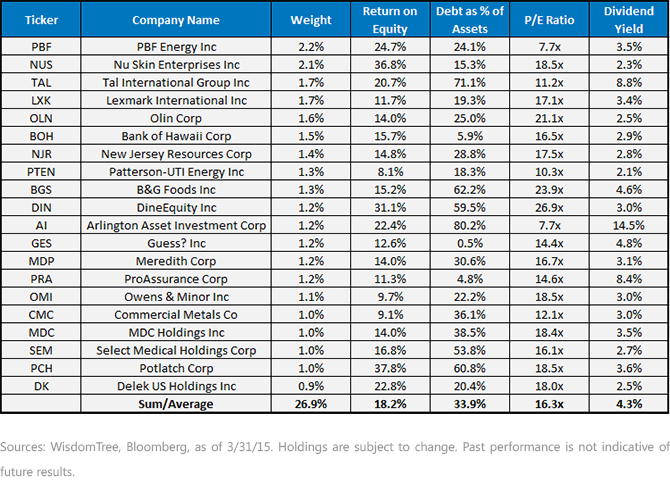Buffett's Checklist Applied to Small Caps


 At WisdomTree, we believe that focusing on quality factors, such as high profitability and low leverage, through rules-based processes can be a compelling investment strategy over the long term. We also believe that these are common traits among firms that consistently grow their dividends and have a high potential to increase their dividends in the future. These high-quality, dividend-growing small caps are also selling at attractive valuations compared to broad based small caps, which we think creates a timely opportunity.
1The annual shareholder letter for Berkshire Hathaway, Inc., available here.
2Scott Patterson and Douglas A. Blackmon, “Buffett Bets Big on Railroad,” The Wall Street Journal, 11/4/09.
3Anthony Bianco, “Homespun Wisdom from the ‘Oracle of Omaha,’” Businessweek, 7/5/99.
4The annual shareholder letter for Berkshire Hathaway, Inc., available here.
At WisdomTree, we believe that focusing on quality factors, such as high profitability and low leverage, through rules-based processes can be a compelling investment strategy over the long term. We also believe that these are common traits among firms that consistently grow their dividends and have a high potential to increase their dividends in the future. These high-quality, dividend-growing small caps are also selling at attractive valuations compared to broad based small caps, which we think creates a timely opportunity.
1The annual shareholder letter for Berkshire Hathaway, Inc., available here.
2Scott Patterson and Douglas A. Blackmon, “Buffett Bets Big on Railroad,” The Wall Street Journal, 11/4/09.
3Anthony Bianco, “Homespun Wisdom from the ‘Oracle of Omaha,’” Businessweek, 7/5/99.
4The annual shareholder letter for Berkshire Hathaway, Inc., available here.Important Risks Related to this Article
Diversification does not eliminate the risk of experiencing investment losses. There are risks associated with investing, including possible loss of principal. Funds focusing their investments on certain sectors and/or smaller companies increase their vulnerability to any single economic or regulatory development. This may result in greater share price volatility. Dividends are not guaranteed and a company currently paying dividends may cease paying dividends at any time. Please read the Fund’s prospectus for specific details regarding the Fund’s risk profile.

Jeremy Schwartz has served as our Global Chief Investment Officer since November 2021 and leads WisdomTree’s investment strategy team in the construction of WisdomTree’s equity Indexes, quantitative active strategies and multi-asset Model Portfolios. Jeremy joined WisdomTree in May 2005 as a Senior Analyst, adding Deputy Director of Research to his responsibilities in February 2007. He served as Director of Research from October 2008 to October 2018 and as Global Head of Research from November 2018 to November 2021. Before joining WisdomTree, he was a head research assistant for Professor Jeremy Siegel and, in 2022, became his co-author on the sixth edition of the book Stocks for the Long Run. Jeremy is also co-author of the Financial Analysts Journal paper “What Happened to the Original Stocks in the S&P 500?” He received his B.S. in economics from The Wharton School of the University of Pennsylvania and hosts the Wharton Business Radio program Behind the Markets on SiriusXM 132. Jeremy is a member of the CFA Society of Philadelphia.

